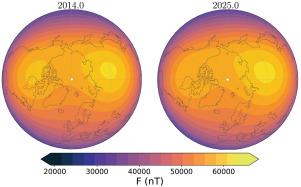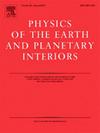Core field changes from eleven years of Swarm satellite observations
IF 1.9
3区 地球科学
Q2 GEOCHEMISTRY & GEOPHYSICS
引用次数: 0
Abstract
The Swarm satellite trio has provided global vector magnetic field measurements, with high precision and absolute accuracy, for the past eleven years. Based on this consistent, high quality, dataset we describe here how Earth’s main (core-generated) magnetic field has evolved between 2014.0 and 2025.0.
At the Earth’s surface, we find that the region in the South Atlantic where the field strength is weakest (below 26,000 nT), has expanded by 0.9% of Earth’s surface area and that the minimum intensity has decreased by 336 nT from 22,430 nT to 22,094 nT. In the northern polar region, we find that in Canada the area of strong field (above 57,000 nT) has diminished, decreasing in size by 0.65% of Earth’s surface area and with the maximum field strength decreasing by 801 nT from 58,832 nT to 58,031 nT. In contrast the corresponding strong field region in Siberia has grown in size, increasing in area by 0.42% of Earth’s surface area, with the maximum field intensity increasing by 260 nT from 61,359 nT to 61,619 nT.
At the core-mantle boundary, reversed flux features under southern Africa have moved westward, converging towards reversed flux features that have moved eastwards under the mid-Atlantic. In the northern polar region a strong flux feature under the Bering strait has moved westwards along the inner-core tangent cylinder. At low latitudes, under Indonesia and the western Pacific, field features have surprisingly moved eastwards. Field accelerations, including oscillations, are found to be most intense at low latitudes.
The Swarm mission has for the past decade been an essential source of global information on the changes taking place in Earth’s main magnetic field. Due to the long timescales of the underlying core processes, extending the mission lifetime for as long as possible, in particular for the higher satellite Swarm Bravo, is expected to yield further scientific insights. A long mission for Swarm Bravo would be an efficient means of ensuring that the present era of high quality geomagnetic observations from space continues as new missions come online.

11年来Swarm卫星观测的核心场变化
在过去的11年里,Swarm三颗卫星提供了高精度和绝对精度的全球矢量磁场测量。基于这个一致的、高质量的数据集,我们在这里描述了2014年至2025年间地球主(地核产生的)磁场是如何演变的。在地球表面,我们发现南大西洋磁场强度最弱(低于26,000 nT)的区域扩大了地球表面积的0.9%,最小强度从22,430 nT减少到22,094 nT,减少了336 nT。在北极地区,我们发现加拿大强磁场(高于57,000 nT)的区域减少了。与此相反,西伯利亚相应强磁场区规模增大,面积增加0.42%,最大场强增加260 nT,从61359 nT增加到61619 nT。在核幔边界,南部非洲的反向通量特征向西移动。向大西洋中部下方向东移动的反向通量特征汇聚。在北极地区,白令海峡下的强通量特征沿着内核切线柱向西移动。在低纬度地区,在印度尼西亚和西太平洋下面,地磁特征出人意料地向东移动。在低纬度地区,包括振荡在内的场加速度是最强烈的。在过去的十年中,Swarm任务一直是地球主磁场变化全球信息的重要来源。由于底层核心过程的长时间尺度,尽可能延长任务寿命,特别是对于更高的卫星Swarm Bravo,预计将产生进一步的科学见解。Swarm Bravo的长期任务将是一种有效的手段,以确保随着新任务的上线,目前从太空进行高质量地磁观测的时代继续下去。
本文章由计算机程序翻译,如有差异,请以英文原文为准。
求助全文
约1分钟内获得全文
求助全文
来源期刊

Physics of the Earth and Planetary Interiors
地学天文-地球化学与地球物理
CiteScore
5.00
自引率
4.30%
发文量
78
审稿时长
18.5 weeks
期刊介绍:
Launched in 1968 to fill the need for an international journal in the field of planetary physics, geodesy and geophysics, Physics of the Earth and Planetary Interiors has now grown to become important reading matter for all geophysicists. It is the only journal to be entirely devoted to the physical and chemical processes of planetary interiors.
Original research papers, review articles, short communications and book reviews are all published on a regular basis; and from time to time special issues of the journal are devoted to the publication of the proceedings of symposia and congresses which the editors feel will be of particular interest to the reader.
 求助内容:
求助内容: 应助结果提醒方式:
应助结果提醒方式:


